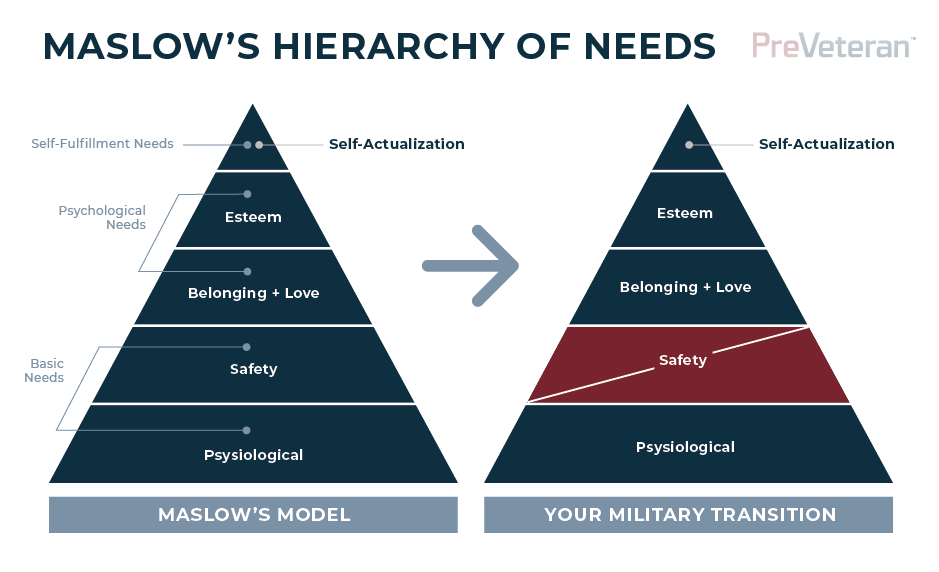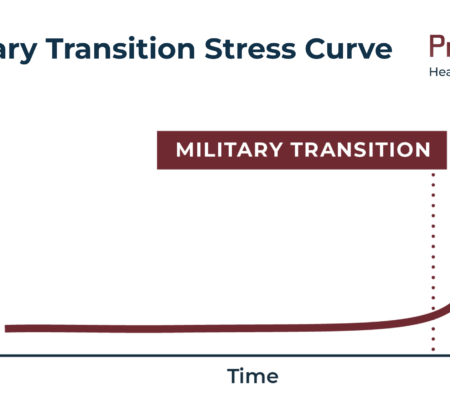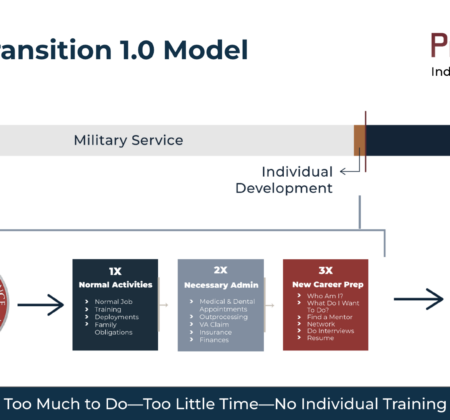If you are a military member transitioning out, is this message playing over and over in your head? “Throughout my military career, I’ve had to overcome lots of challenges and unknowns—military transition will be no different.” If this message hasn’t played in your head yet, you’ll hear this or similar advice from many veteran advocates to try to bolster your confidence as you head into the great unknown of military transition.
While we don’t doubt your or the veteran advocate’s sincerity, it’s important to tell you why this line of thinking is flawed and what you can do to really get ready for your military transition.
Maslows’s Hierarchy of Needs and Your Military Transition
Let’s break down the “I’ve had to overcome lots of challenges and unknowns—military transition will be no different” messaging with the help of Maslow’s hierarchy of needs model. If you’re not familiar with the five-tier model, here is a brief summary. It was proposed by Abraham Maslow in 1943 in his paper titled “A Theory of Human Motivation” that was later published in the Psychological Review. The model’s concept is simple. The pyramid shape indicates that a person’s most fundamental needs are at the bottom, with higher-order needs—such as self-actualization—at the top. The most important point is that an individual’s most basic needs must be met before they become motivated to achieve higher-level needs.

What does this have to do with your military service, you ask? Well, throughout your entire military career, you’ll have a more-or-less intact triangle. The military ecosystem is deliberately designed to address your full spectrum of needs. It covers your basic needs by providing for your health, providing you a paycheck, providing you housing and food. It covers your psychological needs by giving you meaningful work in an organization with other individuals focused on executing critical national security missions. And the military provides the need for self-fulfillment by giving you vacation time as well as money to seek additional education in your areas of interest.
So, as a military member, you are operating with an intact triangle even in the most dire circumstances.
Why Military Transition is Completely Different
Here is where the logic falls apart: the second you leave the military, one of your most basic needs—safety—takes a serious blow.

Here are a few very important examples. If you’re part of the 80% who are separating from the military, your pay goes to zero, which means your ability to purchase food and housing is compromised, not to mention the loss of health care. If you’re part of the 20% that is retiring, you may be slightly better off, but most cannot live on their retirement income alone, particularly if they are the breadwinner and need to support a family.
What You Need to Do to Ensure You Don’t Fall Into This Trap
Hopefully this article puts into sharp focus a couple of very important things you need to know as you begin planning for your transition from the military.
- You do NOT want to weaken your position by putting off the majority of your transition when you’re perilously close to losing your basic safety needs
- You NEED to prepare for your military transition while you are still in the military with a full triangle—the earlier the better
We created PreVeteran to leverage the military ecosystem (where you have a full triangle of needs met), so you can wisely use that time to ensure your military transition will be successful.
Data shows that 90% or more of you will become employees after you leave the military. So start your employment preparation today. The required self-transformation and alignment to the private sector will take time. Use your available time now to get ready, so you can ensure you are well positioned to succeed in a job that you like, that fulfills you, and that brings value to the organization.
PreVeteran’s Employment Prep Course has everything you need to put yourself in the best possible position to succeed. Visit our courses page and sign up for our next class.


